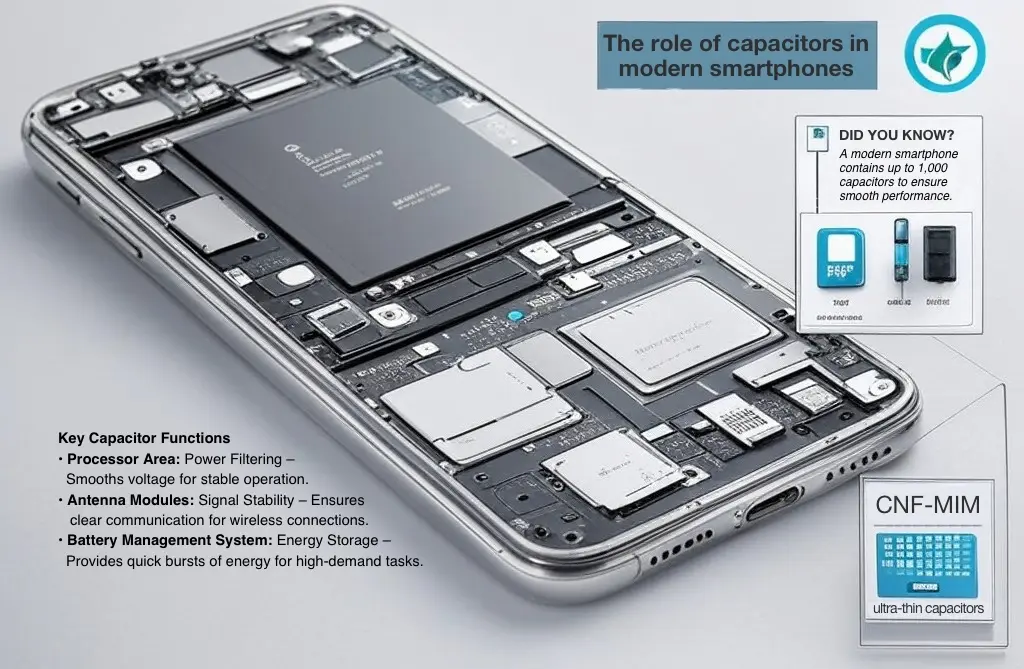Sign up for our newsletter!
Your data will be handled in compliance with our privacy policy.
Your data will be handled in compliance with our privacy policy.

In an age where environmental sustainability is of utter importance, it is crucial to find innovative solutions to reduce energy consumption and minimize our carbon footprint. One such solution is found in capacitors. These unassuming electronic components not only play an important role in various systems, but also offer significant environmental benefits. Albeit very small – if counted one by one.
Fredrik Liljeberg • February 27, 2025
Capacitors are small, extremely small, energy storage components. They are small enough to fit around 1,000 of them inside your mobile phone. Their purpose is to make the functions and features in modern electronic devices work without any hiccups. They are needed for power filtering, buffering, feedback compensation and stabilizing operation requirements of various electronic circuits.
Integration with 5G and 6G technology, growing AI performance, and all other developments in microelectronics are causing the need for these small capacitors to increase in number. In all kinds of devices. And the need for miniaturized capacitors is getting even bigger as the energy transition to cut CO2 emission, for a better social environment, continues.
But do the tiny capacitors really have the capacity to be part of this? Well, it certainly seems so just as it takes a drop of water to create an ocean, or as they say, r the more, the merrier.
Can capacitors reduce energy consumption and minimize carbon footprints for society in general?
Absolutely. By implementing capacitor technology in various sectors, society can achieve significant energy savings and reduced carbon footprints, contributing to a more sustainable and environmentally friendly future.
The environmental benefits of using capacitors in energy-efficient systems are significant and wide-ranging. From energy conservation and renewable energy integration to voltage regulation, energy recovery, carbon footprint reduction, waste reduction, and overall system efficiency, capacitors play a crucial role in promoting a sustainable energy landscape.
As a Smoltek investor, you’re a part of building it.
By embracing the potential of capacitors and integrating them into energy-efficient systems, they can contribute to a greener and more environmentally friendly future.
Capacitors can reduce energy consumption and minimize carbon footprint in several ways:
Reduced Electronics Consumption: Use in energy-efficient LED lights and power supplies reduces electricity consumption in homes and industries.

One type of all miniaturized capacitor technologies is called CNF-MIM, or Carbon Nano Fiber-Metal Insulator Metal. It is short for a carbon fiber-based capacitor technology, built atom by atom, that has the advantage of combining a very high capacitance density (good for the capacitor’s performance) and an extremely small form factor.
This technology also has the advantage of being built on top of the substrate, by adding material for achieving high capacitance density, instead of digging deep trenches in the substrate for the same purpose, making the capacitor either too thick or very brittle.
The potential of CNF-MIM technology has been highlighted in an interview with Dr. Philip Lessner. His assessment acknowledged the groundbreaking capabilities of Smoltek’s CNF-MIM capacitors. This expert validation underscores the industry’s growing interest in additive manufacturing and the revolutionary potential of CNF-MIM technology.
And as the semiconductor industry continues its pursuit of miniaturization and enhanced performance, the demand for high-performing capacitors will only intensify. CNF-MIM technology not only meets these current challenges, but also provides a clear pathway for future advancements. It’s not just a temporary solution but a long-term answer to one of the most pressing challenges facing the electronics industry.
CNF-MIM isn’t just about better capacitors; it’s about the future of electronics. As a Smoltek investor, you’re a part of building it.Want to learn more about the extremely small and ultra-thin CNF-MIM capacitor? Go here!
Your data will be handled in compliance with our privacy policy.